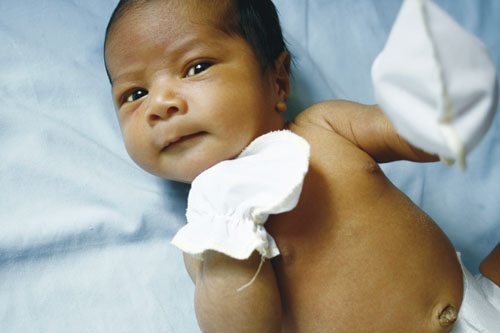What you should know about newborn screening
Jill Levy-Fisch, President of the Save Babies Through Screening Foundation […]
Jill Levy-Fisch, President of the Save Babies Through Screening Foundation joins us today to share her knowledge about screening for newborns and the important information all parents should know about getting their babies tested. As the leader of the only Foundation whose mission is solely dedicated to the advancement of newborn screening, she has played an integral role in changes to newborn screening, including the passage of the NBS Saves Lives Act in 2007/2008. A mother of three children, two with a metabolic disorder, Jill became an advocate for newborn screening eight years ago after embarking on a three-year diagnostic odyssey that led to her youngest child’s diagnosis. Jill served for four years as a member of the Follow-up and Treatment Subcommittee of the Health and Human Services Secretary’s Advisory Committee on Heritable Disorders in Newborns and Children, and is a council member of NYMAC, a regional newborn screening collaborative.

Recently, however, newborn screening has been in the news for different reasons. Court cases in Minnesota and Texas have brought attention to state health department practices regarding the retention and use of filter cards containing the dried blood spots that remain after the newborn screening process is over. Both cases contested the retention and use of these samples by state health departments without express parental consent.
The level of misinformation and fear-mongering around these cases has been staggering. In response to state health department practices alarmists shout: “the government has my baby’s DNA!”, as if access to these dried blood spots was a simple matter of taking them. This kind of rhetoric creates panic and oversimplifies the system in place for use of stored samples, ignoring the safeguards that have been established to protect families. Even worse, these arguments disregard the significant public health benefits that can be gained from these dried blood spots by both families and the newborn screening programs themselves.
For families, the samples can be used to repeat screening in order to verify that you are not contacted unnecessarily with an abnormal result. In addition, for some families these blood spots may be the only medical sample connected to a child who dies or goes missing. As such, these samples are precious tools for identification and testing for these children and families. Without them, questions might go forever unanswered.
For the laboratories, these samples are essential to show that current screening is done efficiently and effectively through the use of quality control and quality assurance practices. They also allow the laboratories to develop new tests for other life-threatening disorders by using samples that are similar to those that will be collected from future babies – another way to expand our ability to save babies lives! And for the public, these samples, if used carefully and with respect for privacy, might teach us a great deal about major health threats or preventive measures that will make life better for all.
To be clear, my organization, Save Babies Through Screening Foundation, supports responsible and approved storage and use of newborn screening dried blood spots in the service of public health. This kind of use requires a number of steps to be successful. First and foremost, we believe that parents need to have a role in making decisions about these dried blood spots. This can only happen through comprehensive education of parents and the public about the entire newborn screening process. Too often parents don’t even realize that their child has had newborn screening, or may not know that the bandage on the baby’s heel was put there after the newborn screen was done. Education using a variety of materials, both before delivery and in the birth facility after delivery, is essential.
In addition to education, families must be allowed to decide how and even if, their baby’s sample will be stored and used for research. Given the option, most parents will choose to act to benefit their child, future children and other children. If not given a choice about research, many will assume ulterior motives and misuse of samples. This will not happen if research is done under the guidelines of Institutional Review Boards and careful adherence to the rules and regulations provided by the 1996 Health Insurance Portability and Accountability Act (HIPAA), the 2008 Genetic Information Nondiscrimination Act (GINA) and state specific patient privacy protections. Parents should know that this system of protections really works!
Save Babies Through Screening Foundation has comprehensive information about newborn screening posted on our website (savebabies.org) and has developed a 15 minute parent education video, available free of charge on the website, that can be used in a variety of settings. It focuses on real-life stories and family experiences with newborn screening.
So take the time to be educated and to make choices for your own child and for the future of newborn screening. The child it saves could be your future child or grandchild!







